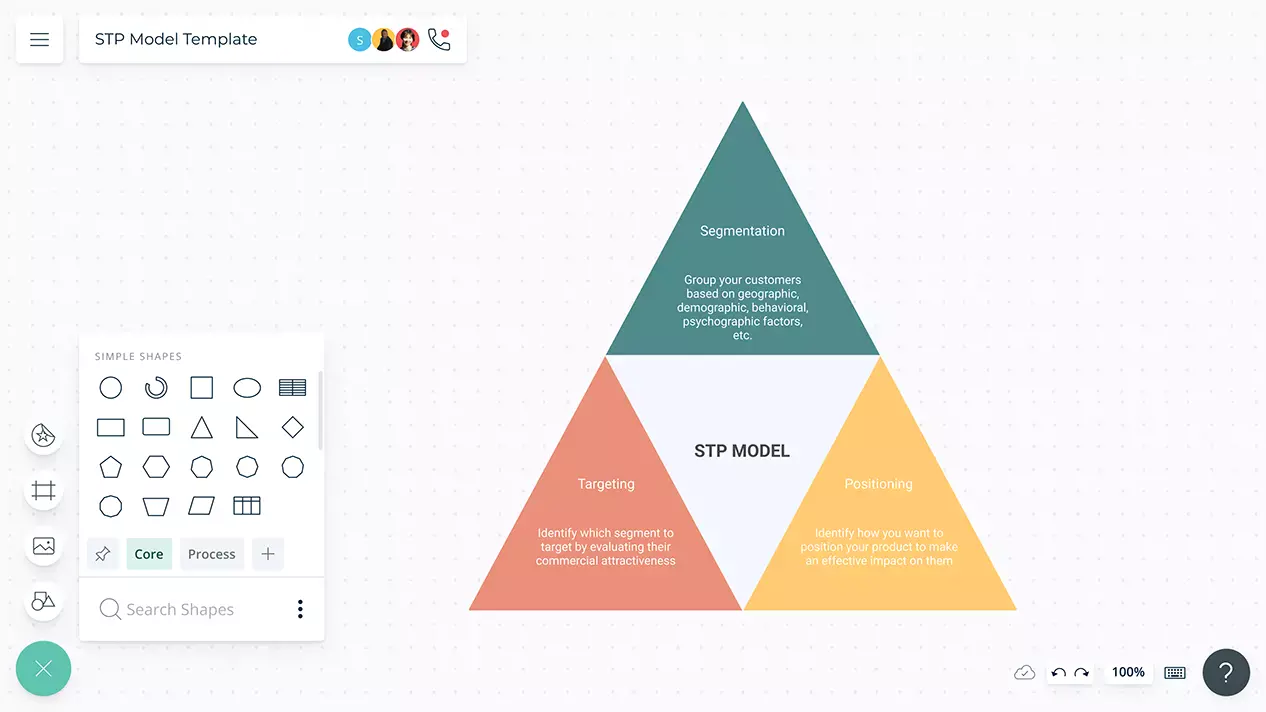STP Model
Create Ideal Marketing Campaigns
Collaborate seamlessly on segmenting your market and developing successful marketing campaigns.
- Segment your market visually to implement ideal marketing strategies
- Real-time collaboration to connect with multiple participants
- Two-way integrations to share your marketing campaigns on popular applications

Over 10 Million people and 1000s of teams already use Creately

Brainstorm Ideas to Segment Markets

Multiple frameworks and templates to cohesively capture your business thoughts in positioning your presence in the right market.
Bring data as CSV, Excel files, or spreadsheets from any source to collect and centralize data on a single canvas.
Freehand drawing and highlights to sketch anything you want as you explain ideas and concepts.
A drag-and-drop interface and Plus Create make it easy to visualize any process or question.
Centralize & Organize All Your Information

Infinite canvas to target, segment, and position marketing strategies of different departments and create one source of truth in a single view.
Documentation capabilities to gather information from different sources into one place.
Full-version history to keep track of key points during each iteration of your segmentation or targeting session.
Use frames inside the infinite canvas to generate different pages like layouts, group content, or build a presentation flow.


Collaborate With Your Teams

Video conferencing baked into the platform to feel like you are in the same room.
Multiple access and role levels to streamline sharing, reviewing, and editing your STP model with clients and stakeholders.
Real-time cursors for any number of participants. Collaborate with family members or peer researchers on a shared canvas.
Do More With Your STP Model

Multiple integrations to easily connect with popular platforms like Github, Slack, Google Workspace, Confluence, and more.
Create data-driven STP models by adding custom data fields and properties.
Link to external documents and open them within the canvas for detailed information.
Export as SVGs, PNGs, JPEGs, and PDFs to publish, present, print, or share.

INTRODUCING

Visualize process and user insights with AI templates

Accessing Creately VIZ
What Is the STP Model?
STP stands for Segmentation, Targeting, and Positioning. It’s a fundamental concept in the application and study of marketing. The model basically helps simplify the segmentation of markets. It guides the process of identifying the most valuable customer segments to your business and coming up with products and marketing material that best suits them.
How to Use the STP Model with Creately?
- Step one is to segment your market; group your customers based on factors such as geographic, demographic, behavioral, psychographic, etc. By doing so you can identify how to customize your product or marketing message to suit each segment.
- Identify which segment to target by evaluating their commercial attractiveness. You can do this by considering factors such as market size, ease of reach, growth potential, profitability, etc.
- Using a tool like the PEST analysis, you can further dig into the threats and opportunities present in each of these markets.
- Now that you have selected the most valuable market segment, identify how you want to position your product to make an effective impact on them.
- To do so, identify your unique selling proposition (USP), or how what you offer stands out from that of what your competitors offer.
- Once your USP is defined, work with a product positioning map to understand how each of your customer segments perceives your product compared to that of your competitors. At the end of the analysis, you can determine how to position your product ideally.
- Identify the needs of the customer segments and the problems of your customers your product can offer a solution for. This information will allow you to create a value proposition that explains how your product will meet the needs of your customers better than your competitors and develop a marketing strategy to execute it.
